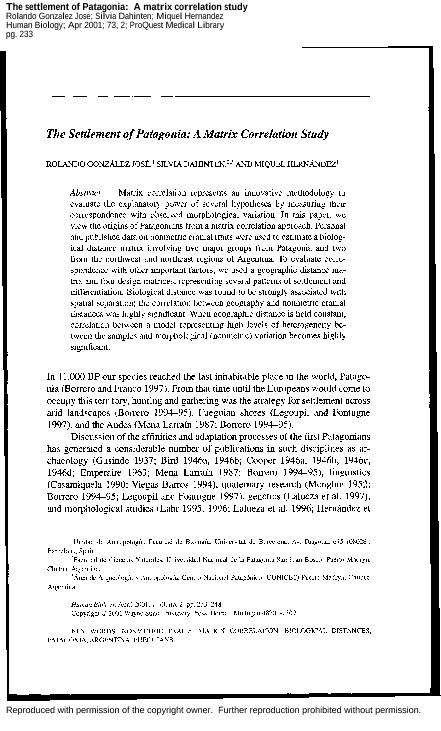Artículo
The settlement of Patagonia: a matrix correlation study
Fecha de publicación:
04/2001
Editorial:
Wayne State University Press
Revista:
Human Biology
ISSN:
0018-7143
e-ISSN:
1534-6617
Idioma:
Inglés
Tipo de recurso:
Artículo publicado
Clasificación temática:
Resumen
Matrix correlation represents an innovative methodology to evaluate the explanatory power of several hypotheses, by measuring their correspondence with observed morphological variation. In this paper, we present the case of the Patagonians’ origins viewed from a matrix correlation approach. Personal and published data on nonmetric cranial traits were used to estimate a biological distance matrix involving five major groups of Patagonia and two from Argentina’s Northwest and Northeast regions. To evaluate correspondence with other important factors, we used a geographic distance matrix and five design matrices, representing several patterns of settlement and differentiation. Data was strongly associated with spatial separation, since the correlation between geography and nonmetric cranial distances was highly significant. When geographic distance is held constant, correlation between a model hypothesizing differents ancestors for Northern and Southern populations and morphological variation is highly significant.
Archivos asociados
Licencia
Identificadores
Colecciones
Articulos(CCT-CENPAT)
Articulos de CTRO.CIENTIFICO TECNOL.CONICET - CENPAT
Articulos de CTRO.CIENTIFICO TECNOL.CONICET - CENPAT
Citación
Gonzalez, Rolando Jose; Dahinten, Silvia Lucrecia V.; Hernandez, Miquel; The settlement of Patagonia: a matrix correlation study; Wayne State University Press; Human Biology; 73; 2; 4-2001; 233-248
Compartir




